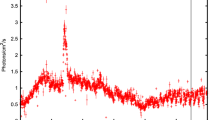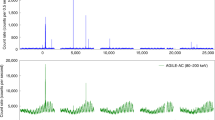Abstract
The rapid X-ray burster, MXB1730–335, discovered by Lewin et al.1 and identified2 with the compact globular cluster Liller 1, produces thousands of X-ray bursts a day when in an active phase. The X-ray bursts have thermal spectra and can be classified into two types by their spectral evolution during burst decay (see ref. 3 and refs therein). Type I bursts normally occur at intervals of hours or days, their spectra soften during decay and their behaviour can be accounted for well by a thermonuclear flash in accreted material on a neutron star. Type I bursts are produced by all other bursters. Type II bursts are unique to the rapid burster, occur at intervals from a few seconds up to 10 min and their spectra do not soften during burst decay. Type II bursts are probably caused by an instability of the accretion flow onto the neutron star. We report here the absence of an IR burst during a type I X-ray burst from MXB1730–335. The upper limit on the IR luminosity during the X-ray burst is 70 times smaller than those of reported IR bursts from this object. This seems to rule out a connection between type I X-ray bursts and the reported IR bursts.
Similar content being viewed by others
References
Lewin, W. H. G. et al. Astrophys. J. Lett. 207, L95–L99 (1976).
Liller, W. Astrophys. J. Lett. 213, L21–L23 (1977).
Lawrence, A. et al. Astrophys. J. 267, 301–309 (1983).
Kulkarni, P. V., Ashok, N. M., Apparao, K. M. V. & Chitre, S. M. Nature 280, 819–820 (1979).
Jones, A. W. et al. Nature 283, 550–551 (1980).
Sato, S., Kawara, K., Kobayashi, Y., Maihara, T. & Okuda, H. Nature 286, 688–689 (1980).
Kunieda, H. et al. Preprint, Nagoya Univ. (1984).
Kleinmann, D. E., Kleinmann, S. G. & Wright, E. L. Astrophys. J. Lett. 210, L83–L86 (1976).
Grindlay, J. E. et al. Nature 274, 567–568 (1978).
McClintock, J. E. et al. Nature 279, 47–49 (1979).
Hackwell, J. A. et al. Astrophys. J. Lett. 223, L115–L119 (1979).
Pedersen, H. et al. Astrophys. J. 263, 325–339 (1982).
Lawrence, A. et al. Astrophys. J. 271, 793–803 (1983).
Lewin, W. H. G. et al. Nature 287, 27–28 (1980).
Author information
Authors and Affiliations
Rights and permissions
About this article
Cite this article
Kawara, K., Hyland, A. & Wainscoat, R. No IR burst during a type I X-ray burst from the rapid burster (MXB1730–335). Nature 309, 770–771 (1984). https://doi.org/10.1038/309770a0
Received:
Accepted:
Issue Date:
DOI: https://doi.org/10.1038/309770a0
- Springer Nature Limited





